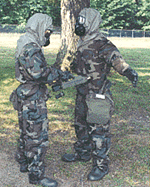
TAB E - The Chemical Agent Monitor
A chemical agent monitor (CAM) is a portable, hand-held device capable of detecting blister or nerve agent contamination on persons, equipment, and elements of the surrounding environment. It is designed so personnel in full protective clothing can easily use it to perform these tasks:
The CAM has a liquid crystal display that shows the mode the detector is using, the battery status, whether the unit is in a warm-up phase, and the relative toxicity of the agent detected.[88]
A CAM draws in vapor samples through its nozzle and analyzes them for molecular composition and mobility. Timing and microprocessor techniques are used to reject interference.[89] When the analysis of the sample is complete, the instrument display projects a read-out to indicate if it has detected chemical warfare agent.
Figure 9. Testing personnel with a CAM
If a CAM detects such an agent, the display shows a number of bars indicating the extent of chemical contamination. If the machine detects no contamination, no bars are visible. If the display shows one, two, or three bars, the machine has detected a low vapor concentration. Four, five, or six bars indicate a high vapor concentration; and seven or eight indicate very high chemical contamination.[90]
A CAM is a point monitor, and cannot determine the vapor hazard over an entire area based on detections at one position. If a CAM has no contact with chemical warfare agent vapors, it will not detect their presence. Furthermore, under some circumstances, liquid agents may not vaporize readily. For these reasons, this detection device works best when used in calm air. Monitoring in still air aids in quickly and efficiently identifying contaminated personnel and equipment.[91]
B. Causes of Inaccurate Detections
Because of the CAM’s sensitivity, many other vapors cause positive detections. Interferents include the substance found in Wipe Number 1 of the M258A1 Decontamination Kit, Decontamination Solution #2 (DS2), insect repellent, brake fluid, burning kerosene, breath mints, burning grass, and ammonia. Other substances that can cause a false-positive reading include perfumes and after-shaves, food flavorings, and cleaning compounds.[92]
Maintaining and using the instrument improperly also can cause inaccurate readings. The CAM can operate at environmental temperatures from -30� to 45� C (-22� to 113� F). At high temperatures the agent reaction chemistry changes and the agent does not ionize the same as at the designated operating temperature range. At low temperatures, chemical agents do not vaporize readily; thus, agent vapor concentration is too low to be detected.[93]
| First Page | Prev Page | Next Page |